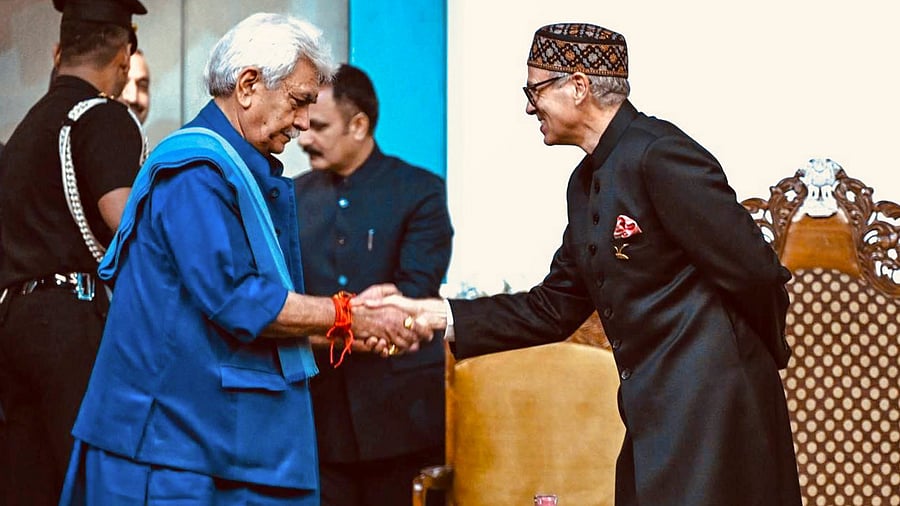
Jammu and Kashmir Lieutenant Governor Manoj Sinha with CM Omar Abdullah
Credit: PTI Photo
Jammu and Kashmir, a region long at the crossroads of conflict, politics and governance, is now witnessing a new power tussle between the elected government led by the National Conference (NC) and the Raj Bhavan.
Despite Chief Minister Omar Abdullah’s efforts to assert his authority, the central government, led by Lieutenant Governor (L-G) Manoj Sinha, has maintained a firm grip on governance since the formation of the government in October of the previous year.
The tension between the two constitutional authorities came to a head last week when the L-G made the controversial decision to transfer 48 Jammu and Kashmir Administrative Services (JKAS) officers without consulting the government.
This move, according to critics, seems designed to undermine Abdullah’s
position and embarrass him publicly. Over the past few months, the L-G administration has increasingly sidelined the Chief Minister.
In protest, the NC and its ally Congress passed a resolution condemning the L-G’s actions, accusing him of overstepping his powers by transferring officers and warning the Centre-appointed L-G not to “push them to the wall” or interfere with the functioning of the government.
The L-G defended his decision, asserting that his actions were in line with the J&K Reorganisation Act of 2019. The Act clearly states that the L-G holds control over matters related to public order, police, the bureaucracy, and the anti-corruption bureau, while governance-related affairs fall under the jurisdiction of the government. The Act also grants the L-G final discretion in matters requiring his action, stating that any decisions made by the L-G in his discretion cannot be questioned in court.
However, the transfer order was only the latest in a series of actions that have placed Abdullah’s government under increasing pressure—not only from opposition parties but also from his own party members, who accuse him of failing to deliver on the NC’s election promises. These included restoring Article 370 and statehood, releasing political prisoners, and reviewing the cases of employees dismissed for alleged ties to militancy, alongside promises of various welfare measures like free LPG cylinders, electricity, healthcare, and food.
Yet, in his first six months in office, Abdullah has not managed to fulfil or even initiate any of these promises. The constraints of a Union Territory (UT) setup have severely limited his ability to take action. It is clear to him and his colleagues that the Reorganisation Act not only dismantled the remnants of Article 370 but also effectively dissolved the former state of Jammu and Kashmir.
Following the 2019 constitutional changes, the new Legislative Assembly is significantly different from previous ones, with Abdullah himself remarking just before the elections that he could not imagine a scenario where he would need to ask the L-G to approve even routine administrative decisions. The recent transfer of revenue officers, who also function as magistrates, further underscores the centralisation of power under the L-G, who acts as the head of law and order.
Historically, the Raj Bhavan has represented the central government’s authority, even when Jammu and Kashmir had a special status under Article 370. However, this dynamic changed drastically after August 5, 2019, when the region’s special status was revoked and it was reorganised into two Union Territories—Jammu and Kashmir and Ladakh. Since then, the division of powers between the government and the L-G has become increasingly unclear, fuelling a power struggle.
The absence of business rules, which outline the powers and responsibilities of the chief minister, the Cabinet, ministers, and administrative secretaries, has created more confusion. But with or without business rules, in a democracy, the government is supposed to represent the will of the people. On the other hand, the L-G, appointed by the President of India, holds significant constitutional powers.
This creates a tension, especially when the political ideologies of the UT’s government clash with those of the central government. In Jammu and Kashmir, this tension is amplified by the region’s complex political landscape, which includes aspirations for greater autonomy, regional representation, and national integration.
The functioning of the UT assembly, the passage of key bills, and the approval of policies often see the L-G office intervening, delaying, or questioning decisions made by the government. Such actions are seen by many as an infringement on the democratic process, leading to frustration among regional political parties.
While the central government may argue that this arrangement is necessary for the stability and integration of the UT, it must also acknowledge the importance of democratic legitimacy and political
participation. Without addressing the
concerns of the people and restoring
J&K’s statehood, the Centre risks exacerbating the alienation and resentment of the population.
As tensions continue to rise between the Raj Bhavan and the government, it is important for both sides to engage in constructive dialogue. A respectful approach to democratic rights, alongside effective governance, will be key to ensuring that Jammu and Kashmir moves toward a more stable, inclusive future—one in which the voices of its people are genuinely heard and represented.